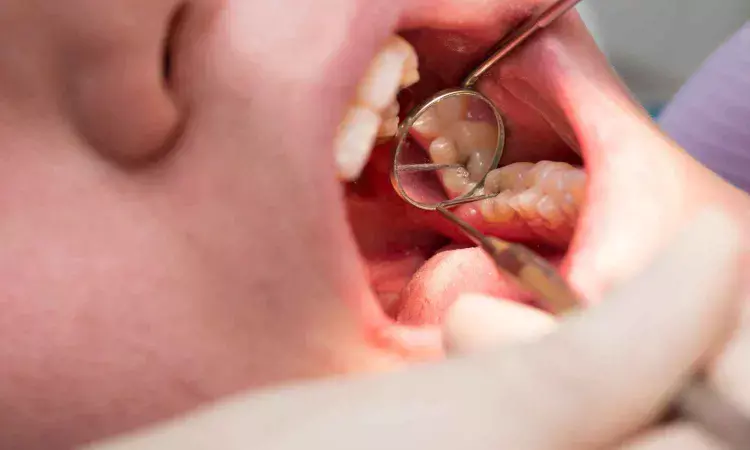- Home
- Medical news & Guidelines
- Anesthesiology
- Cardiology and CTVS
- Critical Care
- Dentistry
- Dermatology
- Diabetes and Endocrinology
- ENT
- Gastroenterology
- Medicine
- Nephrology
- Neurology
- Obstretics-Gynaecology
- Oncology
- Ophthalmology
- Orthopaedics
- Pediatrics-Neonatology
- Psychiatry
- Pulmonology
- Radiology
- Surgery
- Urology
- Laboratory Medicine
- Diet
- Nursing
- Paramedical
- Physiotherapy
- Health news
- Fact Check
- Bone Health Fact Check
- Brain Health Fact Check
- Cancer Related Fact Check
- Child Care Fact Check
- Dental and oral health fact check
- Diabetes and metabolic health fact check
- Diet and Nutrition Fact Check
- Eye and ENT Care Fact Check
- Fitness fact check
- Gut health fact check
- Heart health fact check
- Kidney health fact check
- Medical education fact check
- Men's health fact check
- Respiratory fact check
- Skin and hair care fact check
- Vaccine and Immunization fact check
- Women's health fact check
- AYUSH
- State News
- Andaman and Nicobar Islands
- Andhra Pradesh
- Arunachal Pradesh
- Assam
- Bihar
- Chandigarh
- Chattisgarh
- Dadra and Nagar Haveli
- Daman and Diu
- Delhi
- Goa
- Gujarat
- Haryana
- Himachal Pradesh
- Jammu & Kashmir
- Jharkhand
- Karnataka
- Kerala
- Ladakh
- Lakshadweep
- Madhya Pradesh
- Maharashtra
- Manipur
- Meghalaya
- Mizoram
- Nagaland
- Odisha
- Puducherry
- Punjab
- Rajasthan
- Sikkim
- Tamil Nadu
- Telangana
- Tripura
- Uttar Pradesh
- Uttrakhand
- West Bengal
- Medical Education
- Industry
Caries Detection in Orthodontic Patients by smartphone photography Shows High Sensitivity but Low Specificity: Study

A recent study investigated the utility of smartphone photography for detecting dental caries in patients undergoing fixed orthodontic therapy and found that this approach offers a promising yet nuanced diagnostic tool. With the increasing adoption of tele-dentistry and digital monitoring, clinicians and patients alike are seeking reliable methods for remote assessment of oral health.
This study evaluated whether images captured with standard smartphones could accurately identify carious lesions among patients with braces, who often face additional challenges in oral hygiene and visual inspection due to brackets and wires.
The findings revealed that smartphone photography demonstrated high sensitivity, meaning it was effective at correctly identifying teeth with caries, allowing early intervention and potentially preventing disease progression. However, the method showed lower specificity, indicating that healthy teeth were sometimes mistakenly identified as having caries.
This overdiagnosis could lead to unnecessary clinical evaluations, increased patient anxiety, or unwarranted treatments if not carefully interpreted. Despite this limitation, the study supports the use of smartphone-based photographic assessments as a screening tool, particularly in settings where in-person dental visits are limited or for preliminary monitoring between appointments.
The research underscores the importance of combining photographic assessments with clinical judgment and, when needed, conventional diagnostic methods such as radiographs and direct visual examination. As dental care increasingly incorporates digital and remote technologies, the study highlights both the potential and the limitations of relying solely on smartphone images for caries detection. Clinicians should be aware of the tendency toward false positives and ensure that follow-up evaluations confirm findings before initiating interventions.
Future research is warranted to optimize image capture techniques, enhance diagnostic algorithms, and explore artificial intelligence applications that may improve specificity without compromising sensitivity. By carefully integrating smartphone photography into clinical workflows, dental professionals can enhance patient monitoring, provide timely preventive care, and improve overall outcomes for orthodontic patients.
Dr. Shravani Dali has completed her BDS from Pravara institute of medical sciences, loni. Following which she extensively worked in the healthcare sector for 2+ years. She has been actively involved in writing blogs in field of health and wellness. Currently she is pursuing her Masters of public health-health administration from Tata institute of social sciences. She can be contacted at editorial@medicaldialogues.in.
Dr Kamal Kant Kohli-MBBS, DTCD- a chest specialist with more than 30 years of practice and a flair for writing clinical articles, Dr Kamal Kant Kohli joined Medical Dialogues as a Chief Editor of Medical News. Besides writing articles, as an editor, he proofreads and verifies all the medical content published on Medical Dialogues including those coming from journals, studies,medical conferences,guidelines etc. Email: drkohli@medicaldialogues.in. Contact no. 011-43720751


